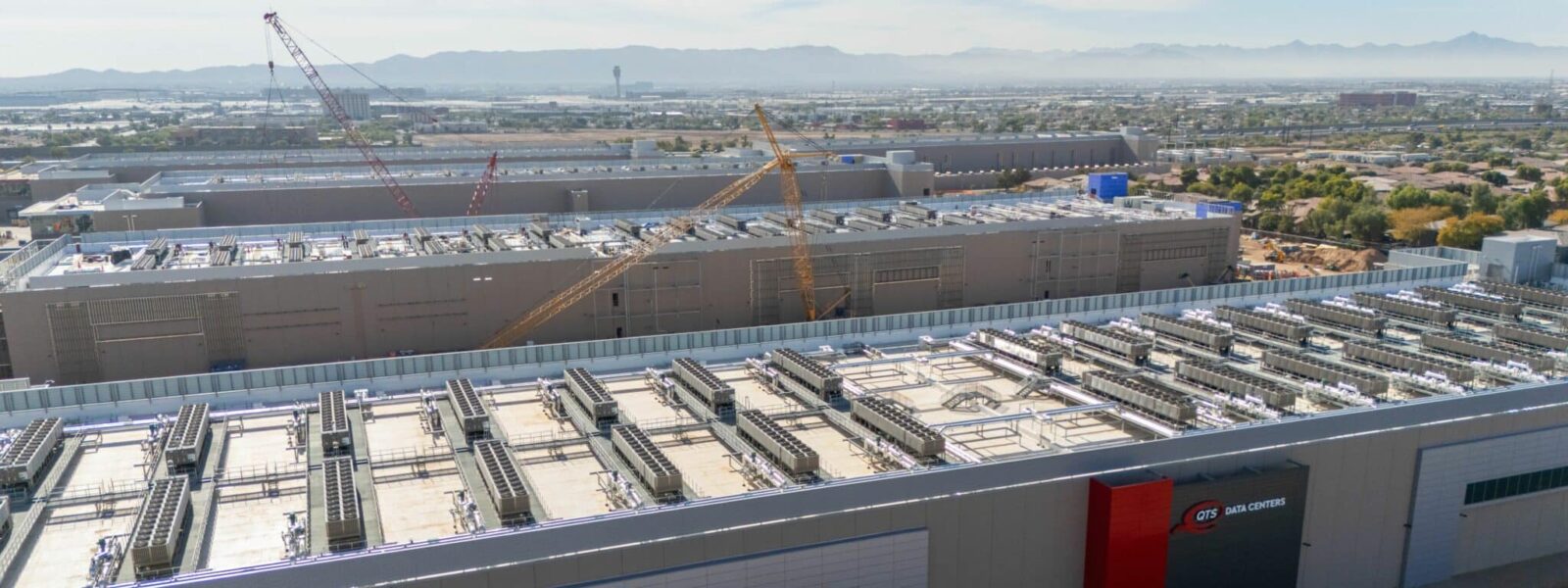Data centres: must we choose between digital tech and ecology?
- Data centres are at the heart of digital development, and the European Commission estimates that they account for nearly 3% of electricity consumption in the EU.
- In France, the annual electricity consumption of data centres is estimated at 10 TWh in 2023 and could reach 28 TWh per year by 2035.
- The cloud is not immaterial, and all data exchanges rely on physical infrastructure.
- The location of data centres is primarily based on economic criteria, with environmental considerations often taking a back seat.
- In Europe, energy optimisation is often offset by growing demand linked to technologies such as generative AI.
In Europe, data centres are becoming hubs of digital development; driven by the widespread adoption of cloud technology, a rise in online services and the growing integration of artificial intelligence into public and private services. Their proliferation is accompanied with an unprecedented level of investment: according to Euronews, plans to set up data centres have increased by 168% in one year, focusing around hubs in London, Frankfurt and Paris1. The phenomenon is linked to digital sovereignty and economic and fiscal issues, with each Member State seeking to attract these strategic foundations.
At the same time, their impact on local resources is beginning to show. The European Commission estimates that data centres account for nearly 3% of the electricity consumed in the European Union2. In Ireland, this share will reach 21% according to figures from the national energy authority for 20233. Other tensions are emerging, particularly in Madrid and Marseille, where several projects have raised concerns about their water consumption for cooling, given the frequent droughts in the region4.
Faced with these changes, the European Commission is imposing transparency requirements on energy and water consumption through the Energy Efficiency Directive, to contribute to the target of an 11.7% reduction by 20305. In response, some industrial initiatives are seeking to reduce their footprint through heat recovery for district heating, passive cooling and software optimisation, among other measures. In Saint-Denis, for example, heat from a data centre supplies the urban network, while other projects are looking at linking it to transport or leisure systems6.

In order to sort out the facts from the fiction regarding these intertwined concerns of technological development, environmental constraints and territorial strategies, two researchers offer some explanatory insights. Cécile Diguet, an urban planner at Studio Dégel who headed the urban planning and development department at the Paris Region Institute for nine years, co-authored Sous le feu numérique. Spatialités et énergies des data centres (Under digital fire: Spatialities and energies of data centres), published in the journal Géocarrefour7. Clément Marquet, a sociologist at the CNRS, is interested in the materiality of digital infrastructure. He is the author of Ce nuage que je ne saurais voir. Promouvoir, contester et réguler les data centers à Plaine Commune (The cloud I cannot see: promoting, contesting and regulating data centres in Plaine Commune), published in the journal Tracés, in which he analyses the social and political dynamics linked to data centres in Plaine Commune.
The cloud is ‘intangible’ and therefore environmentally friendly → False
In France, the annual electricity consumption of data centres was estimated at 10 TWh in 2023. According to projections by the French Electricity Transmission Network (RTE), this consumption could reach 28 TWh per year by 2035. If all the projects announced go ahead and data centres use their full capacity, consumption could even rise to 80 TWh per year, or around 15% of France’s current nuclear production8.
“The cloud relies on data centres,” points out urban planner Cécile Diguet, “these buildings that need to be constructed, consume a lot of electricity and are necessary to operate and cool the servers. This cooling is essential because servers generate a lot of heat.” She adds: “The vocabulary of digital technology – “immaterial”, “wireless”, “dematerialised” – deliberately obscures the material reality and impact of digital technology.” Sociology researcher Clément Marquet adds: “There is nothing immaterial about the cloud: all data exchanges rely on physical infrastructure.” Furthermore, “in the industry, it is common to say that the cloud is someone else’s data centre.”
The material dimension goes beyond buildings alone. Clément Marquet points out that “the manufacture of computers requires the extraction of minerals, with destructive effects on ecosystems, soil, water and air.” He points out that “chip engraving is very water-intensive” and “electronic waste causes significant pollution.” These effects, although indirect, are structurally linked to the functioning of the cloud.
Data centres are the main drivers of digital energy consumption → Uncertain
Terminals, including computers, televisions, smartphones, connected devices, remain the largest source of digital energy consumption, accounting for more than 50% of global demand. Networks and data centres share the rest: approximately one-third for the former and just under 15% for the latter9. In 2022, data centres consumed between 240 and 340 TWh, or 1 to 1.3% of global electricity demand10.
This distribution is changing rapidly under the influence of generative AI, cloud computing and streaming, which are significantly increasing the consumption of digital factories11. Clément Marquet distinguishes between distributed and centralised infrastructure: “Terminals consume more, but in a dispersed manner. Data centres concentrate their demand, which creates specific tensions on networks.” This pooling causes local pressures that are invisible in overall balances. Cécile Diguet points out that “digital technology relies on three major infrastructures: networks (around one-third of the carbon impact), data centres (around 40%) and equipment. They also contain hardware and networks, making them a central and visible infrastructure, unlike networks, which are often buried underground.”
“Data centres therefore cause localised environmental problems that cannot be reduced to a global comparison between terminals, networks and data centres,” notes Clément Marquet. “The rapid rise of generative AI is exacerbating this pressure: these infrastructures, which are very energy-intensive but less dependent on the network, tend to be scattered across rural areas. Their size and intensity nevertheless pose many challenges.”
The location of data centres is primarily dictated by environmental criteria → False
The location of data centres is primarily based on economic criteria: taxation, energy costs, available land, political stability and legal certainty. Environmental arguments, often highlighted in communication strategies, are not decisive at European or global level. Clément Marquet points out that “attractiveness policies play an important role,” citing Northern Virginia as an example. Dublin and Amsterdam have benefited from favourable taxation, and Spain is positioning itself thanks to active support from the public authorities.
In France, certain measures are enhancing attractiveness: “For local authorities, the property tax is what makes these infrastructures so attractive,” explains Cécile Diguet. “For inter-municipal communities, the benefits are limited. It is mainly the State that intervenes through reductions in electricity taxes, in particular the TICFE, which is an important lever for operators.”
However, this attractiveness does not guarantee coherent local integration. Clément Marquet notes that “these policies often neglect land use planning: they take little account of integration or local conditions.” They may also be accompanied by specific statuses (critical architecture, national interest), inhibiting environmental requirements. Ireland is a case in point: its favourable tax regime has attracted many centres, but their concentration has saturated the networks, leading to a moratorium in Dublin in 202112. In the Netherlands, some projects have been suspended due to their excessive impact on land and energy.
Data centres have become critical infrastructure for governments → True
Data centres host essential services in major sectors such as healthcare, defence, government and finance. Their security has become a matter of digital sovereignty and national security, with their protection considered a priority for economic and social stability, “especially when they host sensitive data (health, government departments, military),” says Cécile Diguet. “Some are classified as OVIs. The military often uses its own data centres and networks. Data centres are essential to guarantee digital sovereignty, and the state can create them to secure strategic data.”
The designation of an operator of vital importance (OVI) is intended to protect these critical facilities. In Europe, governments are seeking to secure strategic data in a context of growing threats, particularly with the rise of generative AI. But Clément Marquet points out that “this status is often highlighted, particularly in the context of competition around AI,” adding that “this has prompted countries such as the United Kingdom, and soon France via Article 15 of the Economic Simplification Act, to recognise data centres as structures of national importance.” This recognition has concrete effects: “On the power of local elected officials, land artificialisation and environmental procedures.” This is a different logic from that of OVIs, which are ‘linked to the protection of state data and more modest projects.’
European data centres are greener than those in other regions thanks to a cleaner energy mix → Uncertain
The European energy mix, such as nuclear power in France and hydroelectricity in Sweden, may seem conducive to reducing carbon footprints. But this does not guarantee a lower overall impact. Other factors come into play, such as facility design, thermal management, use of materials and rapid growth in digital usage.
Cécile Diguet highlights the limitations of this reasoning: “There are major differences between countries: France highlights its use of nuclear power, but this also has its own impacts, particularly on waste. Gains in energy efficiency are quickly offset by increased usage. Greater efficiency does not necessarily mean lower consumption. At the local level, data centres can compete with other electricity needs, such as transport or industry. The impact is therefore also felt at the regional level.”
Energy optimisation certainly leads to savings, but these are often offset by growing demand linked to technologies such as generative AI. This rebound effect partly cancels out the environmental benefits. Resource use also remains an issue, regardless of the energy source13.
Clément Marquet shares this view: “The energysource mix is certainly an important factor, but it varies from country to country. It is not enough to guarantee a low impact. The environmental impact of digital technology is not limited to CO₂ emissions: it also includes resource consumption, water, waste, etc.” Furthermore, “the growing needs of digital technology, particularly in relation to generative AI, are adding to other low-carbon electricity needs (mobility, industry, heating). This competition may slow down the energy transition and prevent the decarbonisation of other sectors at the local level.’















